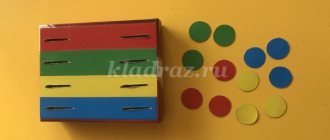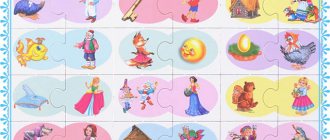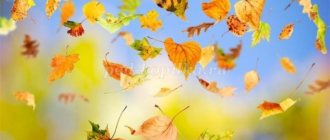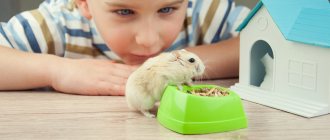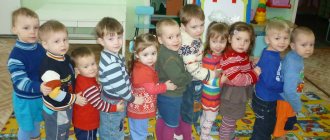Long-term plan for introducing nature to the first junior group
Kulkova Yulia
Long-term plan for introducing nature to the first junior group
September
Topic 1. “Carrot from the Bunny”
.ABOUT.
A. Solomennikova. Introduction to nature in kindergarten . Second early age group . pp. 20-21. Expand children's understanding of vegetables (carrots)
.
Develop a friendly attitude towards others. Toy bunny, whole and grated carrots. 1. Verbal. 2. Visual. 3. Gaming. Examination of vegetables and fruits, illustrations of them; targeted walk to the garden; modeling carrots; p/i “The little white bunny is sitting”
.1. Joint walks to the garden. 2. Joint work in the garden.
October. Topic 2. “Leaf fall, leaf fall, yellow leaves are flying...”
.
O. A. Solomennikova. Introduction to nature in kindergarten . Second early age group . pp. 21-23. Give children a basic understanding of autumn changes in nature . To develop the ability to determine the weather by external signs and consistently, according to the season, dress for a walk. Learn to identify the trunk, branches and leaves of trees. Doll Masha and clothes for her. 1. Verbal. 2. Visual 3. Game. Observation of wind, rain, sun, sky. Looking at autumn leaves. Games “We are autumn leaves”
;
"Sun and Rain"
. Drawing autumn leaves. Conversation about the signs of autumn.
November. Topic 3. “Fish swims in water”
.
O. A. Solomennikova. Introduction to nature in kindergarten . Second early age group .
pp. 23-24. Give children a basic understanding of aquarium fish. Generate interest in the inhabitants of the aquarium. Aquarium with fish, food for them. 1. Verbal. 2. Visual. 3. Gaming. Looking at shells and pebbles in an aquarium; finger game “Fish swims in water”
. Looking at illustrations of aquarium fish.
December. Topic 4. “At the feeder”
.
O. A. Solomennikova. Introduction to nature in kindergarten . Second early age group . pp. 24-26. Give children a basic understanding of bird feeders. Develop a kind attitude towards birds and a desire to take care of them. Bird feeder, envelope with letter, bird food. 1. Verbal. 2. Visual. 3. Gaming. Observation of birds flying to the site; p/i “Birds are flying”
,
“birds in nests”
,
“Sparrows and a car”
.
Drawing “Bird food”
.
January. Topic 5. “Snowman and Christmas tree”
.
O. A. Solomennikova. Introduction to nature in kindergarten . Second early age group . pp. 26-27. Expand children's understanding of trees; show the properties of snow, form a friendly attitude towards the surrounding world. Snowman toy; spruce (growing on the site)
.
1. Verbal. 2. Visual. 3. Gaming. Learning poems about nature ; making a snowman. Drawing "Herringbone"
.
February. Topic 6. “Kitten Fluff”
.
O. A. Solomennikova. Introduction to nature in kindergarten . Second early age group . pp. 27-29. Give children an idea of domestic animals and their babies; introduce you to Russian life; develop a kind attitude towards animals. Panorama of a Russian hut, stove, toy kitten. 1. Verbal. 2. Visual. 3. Gaming. Examination of illustrations depicting domestic animals, nursery rhyme “The cat went to the market”
, poem by V. Berestov
“Kitten”
.
Drawing “Tangle for a kitten”
.
March. Topic 7. “Cockerel and his family”
.
O. A. Solomennikova. Introduction to nature in kindergarten . Second early age group .
pp. 29-31. Expand children's understanding of domestic animals and their characteristics. Create a desire to take care of poultry. Panorama of the poultry yard, toys cockerel, hen and chickens. Plasticine, modeling boards, napkins. 1. Verbal. 2. Visual. 3. Gaming. 4. Practical. Playing with toys, reading the poem “Cockerel” by
. Pet monitoring.
April. Topic 8. “Sunny, sunshine, look out the window”
.
O. A. Solomennikova. Introduction to nature in kindergarten . Second early age group . pp. 31-33. Give children ideas about spring changes in nature . To develop interest in natural . Learn to convey the image of the sun in a drawing. Flannelgraph, silhouettes for laying out a spring landscape, a large sheet of paper with a drawn sun circle, brushes, a water jar, napkins. A cloud and an umbrella drawn and cut out of paper. 1. Verbal. 2. Visual. 3. Gaming. 4. Practical. Looking at illustrations of the sun, reading the nursery rhyme “Sun, Bucket”
.
Games “Sunny Bunny”
,
“Sunshine and Rain”
.
Drawing the sun. Observing spring changes in nature .
May. Topic 9. “Here and here, here and here dandelions bloom...”
.
O. A. Solomennikova. Introduction to nature in kindergarten . Second early age group . pp. 33-35. To form children's ideas about dandelions, teach them to identify the characteristic features of a dandelion, and name its parts. Develop a desire to respond emotionally to the beauty of the surrounding nature .
Masha doll, dandelions. 1. Verbal. 2. Visual. 3. Gaming. Looking at illustrations of dandelions. Observing spring changes in nature .
Project for the first junior group “Journey to the natural world”
Loves fish and ants.
Guess who it is? (bear)
Red, fluffy,
Climbing up a pine tree.
Throws cones. (Squirrel)
Tanya: Well done, guys! We need to protect these animals and treat them with care. Since the inhabitants of the forest cannot exist without each other. Our walk through the forest is over, it's time to return to kindergarten.
Music is playing.
Children, holding each other by the shoulders, move around the hall.
Didactic games on environmental education in the 1st junior group
Ecological game “Where the bunny hid!”
Target:
describe, name plants based on their characteristic features and in connection with the environment. Write descriptive riddles and guess riddles about plants.
Rules of the game:
A plant can be named only after describing any of its characteristics one by one.
Progress of the game:
The game is played in the park, in the forest, in the square. A driver is selected from a group of children, the rest are divided into two subgroups. The driver hides the bunny under some plant (tree, bush) so that the other children do not see where the toy is hidden. Then the driver describes the plant (if it is difficult, the teacher helps). Whichever group guesses faster what plant the bunny is under, goes to look for it. For example, a toy is hidden under an oak tree. The leader asks the 1st subgroup a riddle: “This is a tree, it has a strong, mighty trunk” (Answers from the children of the 1st subgroup), to the 2nd subgroup: “The leaves of this tree turn brown in the fall” (Answers from the children of the 2nd subgroup) . Etc.
The description riddles continue until one of the subgroups guesses.
Ecological game “Where does it grow?”
Target:
teach children to group vegetables and fruits, develop quick reaction to the teacher’s word, endurance, and discipline.
Rules of the game:
sort out the vegetables and fruits, and put some in the garden, others in the garden (imitation - pictures of a garden and vegetable garden). The team that quickly puts all the items in their places wins.
Progress of the game:
The children are divided into two teams: vegetable growers and gardeners. Vegetables and fruits (dummies can be used) are laid out on the table. At the teacher’s signal, children sort vegetables and fruits into the ones corresponding to the pictures. The team that finishes the job first wins. Children not participating in the teams check the correctness of the selection.
After this, the winning team is announced. The game continues with other teams.
Ecological game “Our Friends”
Target:
Expand children's ideas about the lifestyle of animals that live in the house (fish, birds, animals), about caring for them, about their homes, cultivate a caring attitude, interest and love for them.
Material:
lotto cards with images of animals: parrot, aquarium fish, parrots, hamster, turtle, etc. Small cards depicting their homes (cage, terrarium, aquarium, box, etc.), food.

